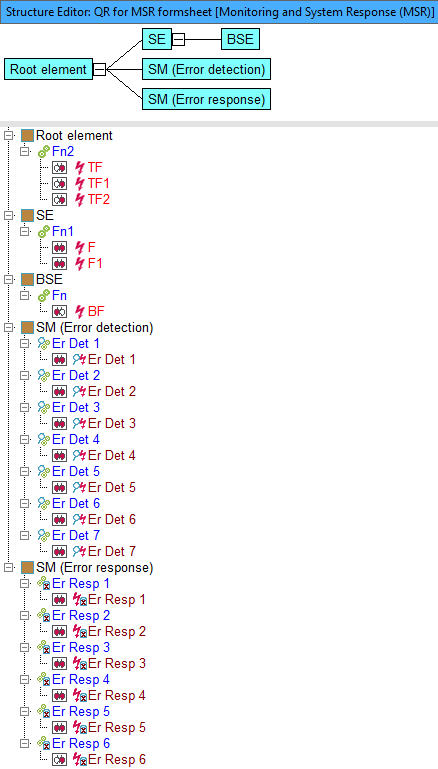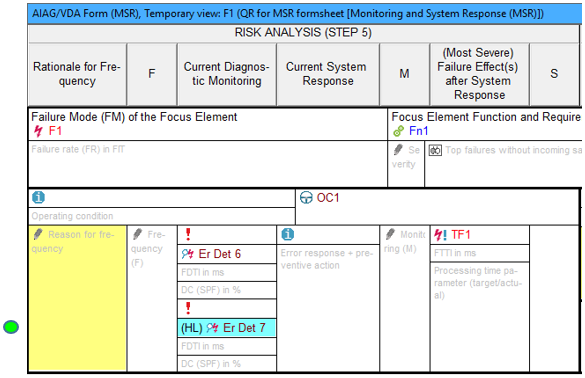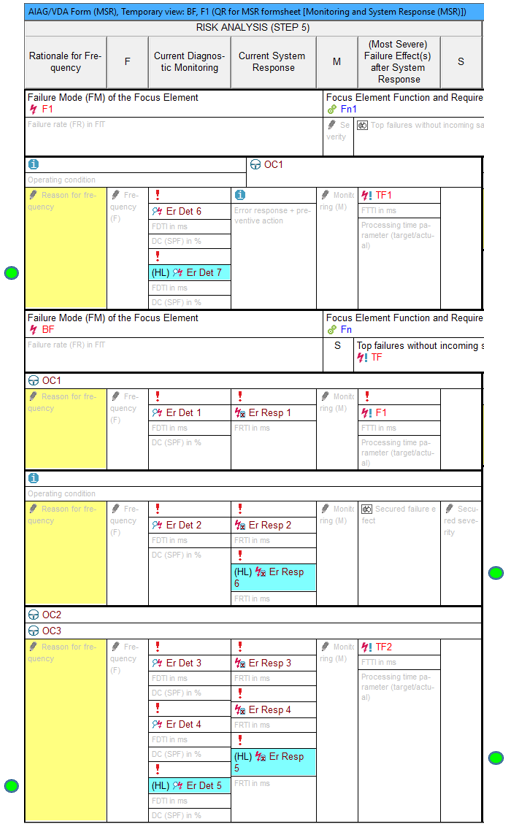Search for:
Mechatronic paths with multiple safety mechanisms of the same type
Explanation:
The MSR form is searched for mechatronic paths that have more than one error detection and/or error response.
Example:
Abbreviations:

- The example to demonstrate how the described quality rule (QR) works has the structure shown above. The contained failures and safety mechanisms are linked with each other as shown in the failure net below:

- The described QR checks the mechatronic paths shown in the MSR form for whether more than one error detection and/or error response occur in these paths. For that purpose, the QR search algorithm starts from the focus failure (in our case: BF), works through the failure paths in the direction of effects and marks those types of safety mechanism in the MSR form which occur repeatedly. The rule is that the search starts “afresh” as soon as a new operating condition (OC) or a new failure is reached in the mechatronic path. The following figure shows how the search result looks in the MSR form focused on the BF:

- Recalling the above fault network, as expected, the type of error reaction Er Resp 6, which occurs repeatedly in the third failure net branch, is shown as the search result. It is also not surprising that Er Det 5 (belonging to OC2) and Er Resp 5 (belonging to OC3) are marked, because these types of safety mechanism occur in the mechatronic path (see fourth failure net branch) for the second time each.
- On the other hand, it seems surprising at first glance that the type of error detection Er Det 7, which is available in the second failure net branch, is not to be found in the MSR form. However, that circumstance can be explained if you consider that not all mechatronic paths that are visible in the failure net or failure graph are usually mapped in the MSR form. That is due to the fact that the form is structured in a way that centers the focus element and thus information can be omitted that does not directly relate to the focus element. In the present example, this includes the safety mechanism Er Det 7, which is to be shown as a QR search result in the second branch of the failure net. Because it does not belong directly to the focus failure BF but to the subsequent failure F1, Er Det 7 is shown in the MSR form only when F1 is itself made a focus failure in the form. If we therefore apply the considered QR to the MSR form focused on F1, we obtain the following search result:

- Therefore, two QR searches had to be conducted in two MSR forms with the two focus elements BF and F1 in order to obtain all possible search results. However, the IQ-Software provides the option to create a single MSR form with several focus elements. To do so, create the first MSR form with the first focus element – in our case BF. Then, create the second MSR form with the second focus element – in that case F1. During the process, the screen shown below opens:

The screen provides you, among other things, with the option to add the new form to the temporary, currently available form view. That allows you to combine both forms in a shared MSR form. Applying the examined QR to the shared form, you will receive the expected number of hits with the following overall search result:
Search result: 

As expected and already explained in detail above, the four safety mechanisms Er Det 7, Er Resp 6, Er Resp 5, and Er Det 5 are marked as hits.